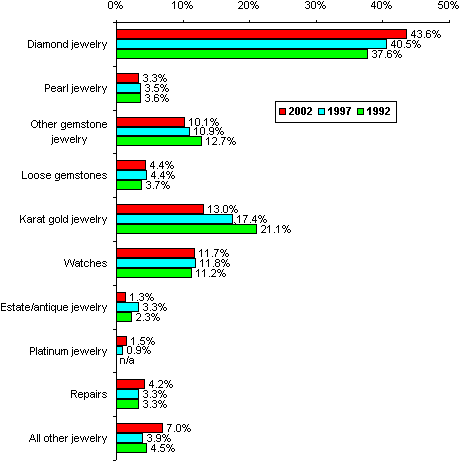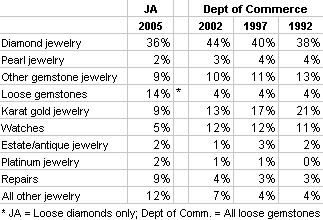IDEX Online Research: Brands & Skilled Staff Key to Higher Retail Margins
April 04, 06
Diamond jewelry sales continue to take market share from other jewelry categories, according to the latest data released by the U.S. Department of Commerce.
Over the past ten years, diamond jewelry sales have increased to 44 percent of a typical U.S. jeweler’s sales, up from 38 percent ten years ago, as the graph below illustrates.
| U.S. Jewelers' Changing Product Mix |
As diamonds have taken market share, the biggest loser has been gold jewelry, which has declined from about 21 percent of sales to only 13 percent of sales for the typical U.S. specialty jeweler in the ten-year period between Business Censuses.
In addition, a general category, “other gemstone jewelry”, has also lost market share; declining to about 10 percent of a jeweler’s sales from 13 percent ten years ago.
The sales mix of most other categories has remained stable. The only exception is platinum jewelry. In the 1992 Department of Commerce Business Census, it was too small to be reported. By the 2002 Business Census, platinum jewelry had risen to 1.5 percent of a typical jeweler’s sales.
Jewelry is classified on the basis of the value of each commodity in a piece of jewelry. For a piece of jewelry to be classified as “diamond jewelry,” the diamonds must represent at least 50 percent of the value of the finished piece. Likewise, for gold jewelry, platinum jewelry, other gemstone jewelry, and pearl jewelry, each of those commodities must represent at least 50 percent of the finished value of the piece for the jewelry to be classified in one of those categories.
Jewelers of America Sales Mix Similar
| Sales by Product Category |
The most glaring difference between Department of Commerce figures and JA figures is in diamond jewelry. The JA survey breaks out “loose diamonds sales” from “diamond jewelry sales.” Further, the JA survey does not list “loose gemstones.” If we assume that virtually all of the “loose gemstones” in the Department of Commerce study are diamonds (a reasonable assumption), then the aggregated numbers (diamond jewelry plus loose diamonds) roughly correlate. In short, diamonds and diamond jewelry represent roughly 50 percent of the sales mix of the typical U.S. jeweler.
The table on the right compares the JA survey to the Department of Commerce surveys.
Diamond Promotions Boost Sales
IDEX Online Research believes that the diamond sales mix gain is largely the result of heavy spending by De Beers related primarily to its concept ‘A Diamond Is Forever’. In addition, the company has generated a steady stream of diamond jewelry concepts – right hand rings, statement jewelry, tennis bracelets, three-stone diamond jewelry, and others – to maintain a high awareness of diamond jewelry in consumers’ minds. While some of the De Beers promotions have been less than successful, they have served to maintain diamond jewelry awareness among American consumers.
With the push for increased marketing partnerships in the diamond pipeline, it is likely that the diamond sales mix will continue to increase, both in the U.S. and globally. Retail jewelers who have not taken advantage of these promotions or who maintain a low mix of diamond jewelry in their stores will lose market share over the longer term.
The biggest challenge for jewelers is to maintain margins with diamonds. Because there is strong demand, too many jewelers use the lowest common denominator – retail price – to try to create a competitive differential. Further, certificates have commoditized diamonds. As a result, diamond jewelry margins are at the lower end of the gross margin range for most jewelers. However, smart jewelers know that the judicious use of branding – either store brands or well-known, well-controlled brands such as Hearts on Fire, Lazare, and others – coupled with trained skilled sales associates will result in higher margins.

